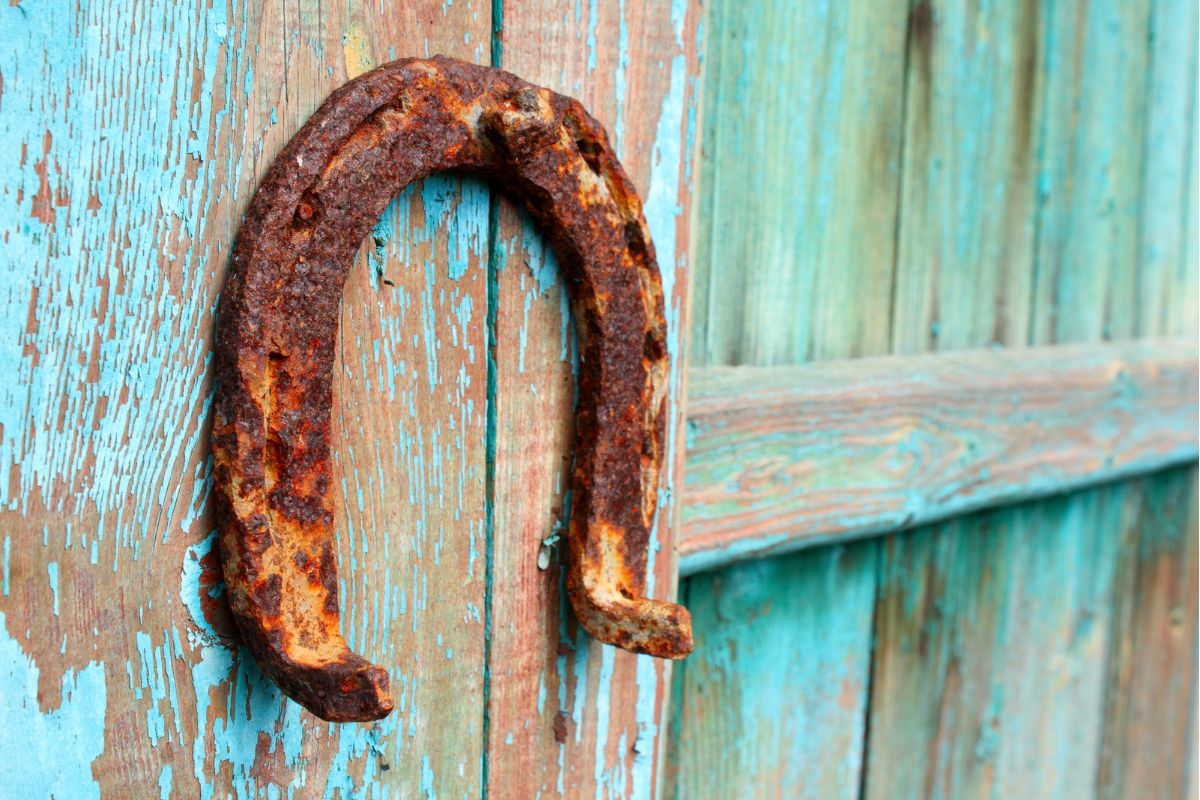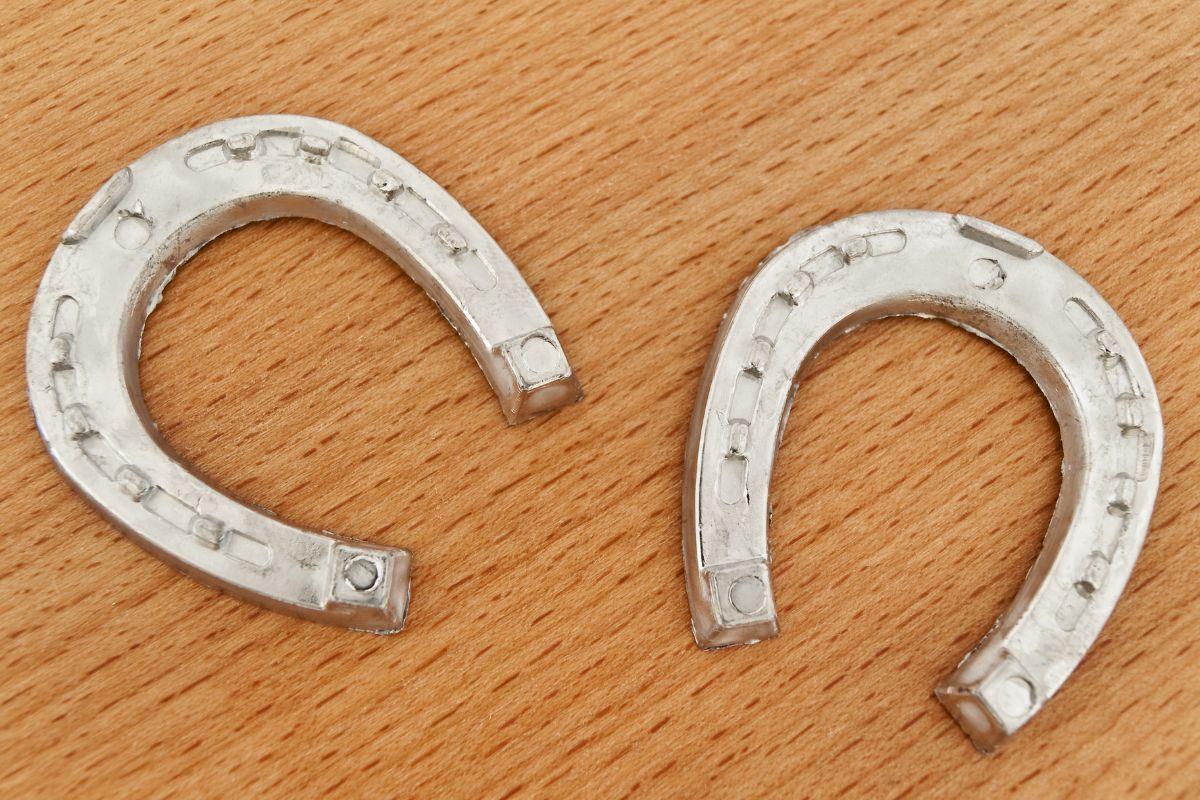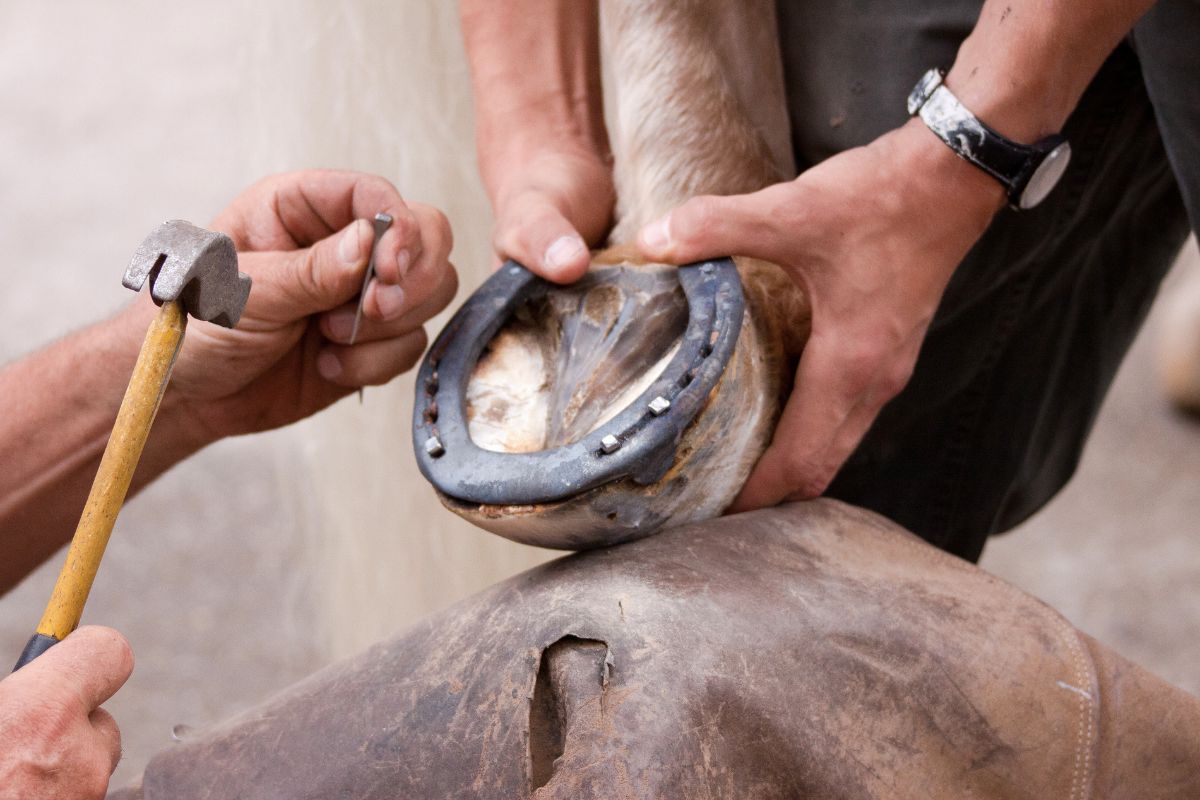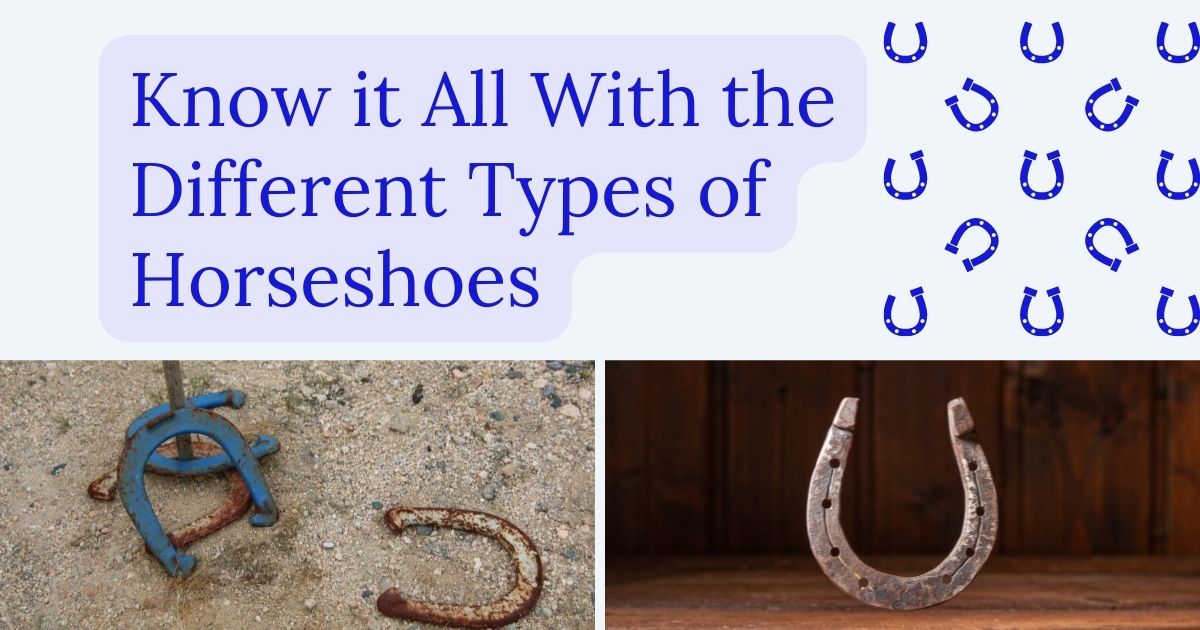Why Do Horses Wear Horseshoes?
Since ancient times, different types of horseshoes have been shielding horses’ hooves from damage. To this day, most horseshoes are metal and fastened to the animal’s hooves with nails. Horseshoes appear to be straightforward, but they have several uses.
Horseshoes help to more uniformly transfer the horse’s weight across the hoof, which can help to avoid problems like chipping or cracking. Horseshoes also prevent overuse of the horse’s hooves and offer grip on slick areas.

What are Horseshoes Made of?
Horseshoes are from odd materials throughout history. According to legend, the first horseshoes ever produced were straps of leather fastened to the hoof and constructed of rawhide filled with grass or other natural materials.
They date to 600 BC and looked more like contemporary boots than shoes. These days, rubber, plastic, steel, and aluminum are the most often used materials for horseshoes. We use these materials frequently to combine their beneficial features to create composite shoes.
Steel
The majority of horseshoes consist of steel. It is well-liked because it is a strong substance that is widely accessible and reasonably priced. The first steel-shoe manufacturing process started in the United States in Troy, Michigan, in 1835. In North America, we frequently refer to steel shoes manufactured by machines as “keg” shoes.
The movement of the horse is also significantly influenced by the steel shoes. They encourage the horse to trot more animatedly by increasing the flexibility of the lower leg joints. Steel shoes are, therefore, the best choice for horses used for carriage and dressage.
Aluminum
Aluminum is the second most popular horseshoe material after steel. According to American Equus, aluminum horseshoes boost a horse’s running speed. They are, therefore, a well-liked option for horses in the racing sector.
Furthermore, an investigation in the Journal of Equine Veterinary Science shows that aluminum horseshoes lessen the animal’s knee action and hoof flight. This enables the horse to move its legs a few seconds more quickly, which might be crucial during a race. Keep in mind that steel weighs around 2.5 times as much as aluminum.
Because they allow for natural hoof expansion and lessen stress on tendons and joints, rubber horseshoes are becoming more well-liked in the equestrian community. They come in various sizes and forms and frequently contain a cushioning pad under the frog to absorb further impact.
Modern rubber horseshoes endure as long as their metal counterparts, although rubber is softer than metal. Depending on the design and the owner’s preferences, they can be either hammered on or bonded to the hoof.
Horses that spend much time traveling, such as carriage or police horses, frequently have metal shoes with rubber coatings. This gives the horse more traction and concussion protection while also quieting the horse’s footsteps.
Plastic (Polyurethane)
Rubber and plastic horseshoe types both have advantages for horses. They may readily be molded to the contour of the horse’s hooves and are often composed of polyurethane. Plastic horseshoes allow for flexibility and expansion because they resemble the natural hoof composition.
Additionally, they are fantastic at protecting bones and joints and cushioning the horse’s feet on rough terrain. Horseshoes made of plastic only have one drawback: they erode more quickly than metal ones.
Composite Resources
Steel and synthetic materials combine to create composite shoes, which are gaining popularity in Europe. These glue-on shoes protect the hoof’s inherent flexibility and allow for healthy functioning, unlike inflexible standard shoes.
Usually made of rubber or plastic, these shoes feature a metal core to boost longevity. While some composite shoes have conventional designs, many offer additional frog support.

The Different Types of Horseshoes and Their Uses
When shoes were a commodity in high demand in medieval Europe, various horseshoe types were already in existence. During that time, blacksmiths created specialized footwear for multiple applications, including military, commercial, and agricultural use.
There are at least 20 distinct varieties of horseshoe types and uses available in the market today, and you can customize each to meet the horse’s requirements. Let’s look at a few of these horseshoes, shall we?
The Regular Horseshoe
The standard horseshoe is the type of shoe that the great majority of horses have on their hooves. A shoe is commonly referred to as a “keg” when a machine has prepared it. Under typical riding conditions, this shoe will support the average hoof and shield it from harm.
The vast majority of horses never require anything farther than this. “Fullers” is the name given to the grooves located where the nail holes are, and all they are is a channel that provides space for the nailheads to sit to make them more secure.
Halveston Bonded Graduated Eggbar
When something is “bonded,” it indicates that there is a rubber compound placed between the shoe and the hoof. This compound helps reduce the consequences of concussions. And by “graduated,” we mean that the heel of the shoe is two to three percent thicker than the rest of the shoe.
This shoe is for a horse suffering from Navicular Syndrome; the graduation alters the hoof and pastern angles to provide comfort for the deep flexor tendon. You can move the point where your foot touches the ground further back by wearing shoes with an egg bar. The egg bar’s back will take the concussion now that it is there.
The design of this particular shoe is for several elements suitable to a certain horse, who was an eventer, and he did not rip the shoes off. If the horse and the conditions called for it, we would not think twice about using a shoe made of drop-forged aluminum, and we would not hesitate to do so.
Century Support Aluminium Shoe With Stud Holes and Side Clips
The Belgian firm, Kerckhaert, created this Drop Forged shoe. Several aluminum shoes in Europe are for eventers and performance horses. The objective is to minimize the weight of the shoes and thus reduce muscle fatigue and the danger of injury.
This is a wide shoe, which offers additional support, and if fashioned of steel, it would be incredibly heavy. This shoe can benefit from extended coverage without the extra weight.
Aluminum Triumph With Side Clips
This is a lightweight performance shoe. You can reinforce the toe of the shoe with a tungsten implant. This is a wide shoe that favors an early break-over.
Comfort Fit
This broad, rolled-toe shoe adds width and support and speeds up the breakover if you have a horse who stumbles or wants to move it away in front a bit quicker. This shoe is beneficial for horses that tend to stumble.
The clips are on the side of this front shoe because the shoe would sit in under the toe. Setting the shoe back also helps to change the horse’s posture if it is a little low in the heels. It is also helpful with tendon injuries and Navicular Syndrome.
Flat Hack With Bar
Bar shoes are for shattered pedal bones or abnormalities inside the hoof capsule. The objective is to immobilize the hoof to reduce expansion and contraction. The tiny bow in the bar enables modification to the width of the shoe.
Remedial Bar Shoe With Toe Extension
This is not a competitive shoe, but it is an example of a farrier’s labor to heal horses with terrible injuries. This hind shoe suits a horse with a nasty argument with a wire fence that destroyed his extensor tendon and sliced through his heel. The bar shoe was for inhibiting the expansion and contraction of the fractured hoof capsule at the heel.
The purpose of the toe extension is to allow the tendon to mend itself while also preventing the horse from knuckling over, which would be due to a lack of tendon support. The horse did perform well enough for less strenuous tasks.
Sigafoos Glue-On With a Kevlar Cuff
Du Pont is the company that invented the very durable synthetic substance known as Kevlar. Between the shoe and polyurethane, the strip is where the Kevlar cuff is sewn onto the shoe to stay in place. Poly is beneficial because of the shock-absorbing characteristics it possesses.
Fasten the shoe to the foot using a Kevlar cuff that cements to the hoof with Equilox. After this, the hoof is glad-wrapped, and a heat gun shrink-wraps the glad wrap onto the hoof to speed up the curing process. Finally, remove the glad wrap.
You would use this on a horse that, for whatever reason, you cannot attach shoes onto. You can do rebuilding the foot with the Equilox and cover it with the Sigafoo if you have a horse missing a significant portion of its foot. While competing in the Adelaide 3-day event (ADE) a few years ago, this shoe was in use on one of the horses.
In addition, there were drills of stud holes in them, and they did not move at all; they were great. On the other hand, the cost is relatively high.
Eggbar With a Jin Hung Square Toed
The aluminum shoe with a square toe and a tungsten insert can easily facilitate breakover.
Shoe made of Aluminum with Studs
There is a possibility that you will witness an increasing number of performance horses wearing aluminum shoes. These shoes are more durable and robust due to the presence of titanium in the metal. Since it does not have screws to hold it in place, the stud on the shoe outside appears to be somewhat questionable.
Heart Bar Shoes
The benefits that the heart bar shoes offer are identical to those provided by conventional bar shoes; however, these shoes also offer frog support. These are frequently for horses that suffer from laminitis.
In most cases, we will add pads or other stand-alone packing materials to fill spaces between the horse’s foot and the frog support. If bar shoes are so effective in supporting the hoof, why aren’t you using them on all of your horses? To begin, there are a few explanations for this:
- Hooves tend to have a certain degree of giving to them. They swell up whenever a horse takes a step, which helps them to absorb the impact better. You can restrict this growth further by wearing bar shoes instead of conventional open-toed ones.
- It is simple for the horse to catch the bar piece at the back of the hoof with its hind hoof, which increases the likelihood that it will fall off. Even though we make it a point to use high nails that, if the shoe comes off, will cause the least amount of damage possible, the hoof wall is nevertheless weakened to some degree by each hole.
- Bar shoes are a little heavier than similar non-bar shoes, which causes your horse to carry more weight than it needs to on the ends of his legs, which increases the risk of stress injuries happening to your horse.
- In most cases, less is more.
Wedge Horseshoes
Wedge horseshoes, which are corrective shoeing as a temporary treatment, are quite similar to bar shoes in appearance. They help correct conformation abnormalities such as a “broken back” hoof-pastern angle or underrun heels in horses. These specialized shoes can enhance soundness and increase performance thanks to the wedges you place in their heels.
You can also make wedge shoes by placing a pad inside the shoe’s back half where the heel would typically be. Even though they are sometimes required, Wedge shoes might be counterproductive if the wearer doesn’t know how to use them properly.
Do Race Horses Wear Horseshoes?
Do racehorses require shoes to compete? Although racehorses don’t need shoes on to participate, virtually all of them will be fit when they go out on the track. Even though racehorses often compete on turf or dirt tracks, which have a gentler surface, their landings nevertheless result in a significant amount of concussive force.
Depending on the terrain of the racetrack and the preferences of the horse’s trainer, a racehorse may need different types of horseshoes to compete. One thing, however, is certain: they want a light shoe that will enable the horse to run to the best of its ability.
Aluminum Shoes
These are the most common type of horseshoes worn by racehorses. The vast majority of racehorses run in aluminum shoes that increase traction by having nail holes that are both smaller and finer.
As a general rule, racehorses and, more especially, thoroughbred horses have feet that have a thin wall, which makes them more susceptible to hoof damage than other types of horses. Add to that that racehorses are within the confines of their stalls for most of the day, and you have a prescription for tragedy waiting to happen.
However, if you have a solid maintenance plan and use the appropriate shoeing techniques, you can keep them in good shape.
Some Racehorses Wear Corrective Shoes.
It is not unheard of for a racehorse to require specialist horse racing shoes due to complications that may develop in their leg or hoof. This is because of the intense training that they undergo. A farrier will construct these one-of-a-kind shoes right there in the stable. Z-bar and V-bar shoes are the two most frequent types of corrective horseshoes used in the sport of horseracing.
When a horse foot has a quarter crack, it utilizes a Z-bar because it helps disperse the weight so that the crack may heal appropriately. A V-bar is on top of the frog to assist the structure in pumping blood, and the enhanced circulation that results from this helps the body to heal.
Most Horseracing Shoes Have a Toe Grab
A toe grip is a component type in the construction of racing shoes. Toe grabs are not a form of shoe in and of themselves; rather, they are an accessory that combines with an aluminum plate. The thin steel bar acts like a cleat, digging into the ground to provide further traction, particularly when moving at fast speeds.
The type of track surface and the required quantity of traction both play a role in determining how high a toe grab should be. An excessively high toe grab might cause lameness because it places excessive tension on the flexor tendons.

Parting Thoughts
The world of horses has had horseshoes for many ages. They have been an essential element of the industry. Whether or not you believe it, some horses require horseshoes to feel comfortable, protect their feet, and maintain their overall health.
They can also provide other benefits, such as protection against hoof injuries, prevention of excessive wear on the feet, and assurance that the animal will not slip and fall while it is wet outside. The horseshoes you throw out do not go to waste because they can be hangers, welded together to create decorations or even utilized in the game of horseshoes.
